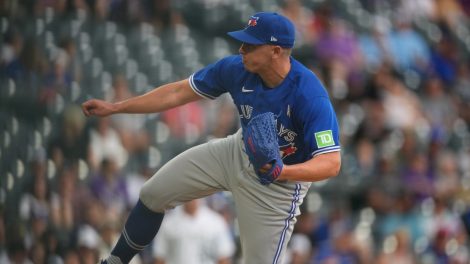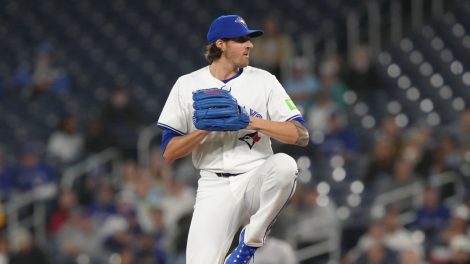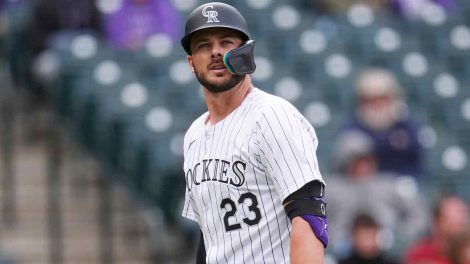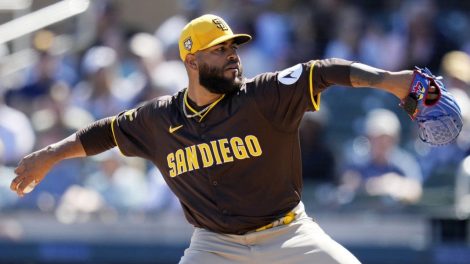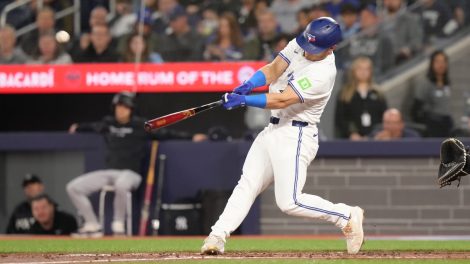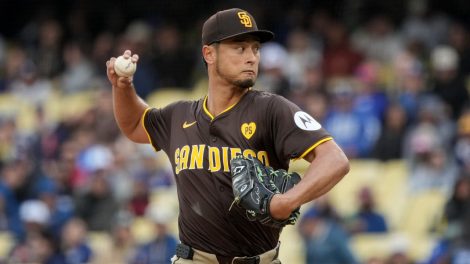Jose Bautista was here at the beginning and he’s still here at the end of whatever this has been for the Toronto Blue Jays.
Everything you will feel these next three days as the ghost of championships future play a three-game series at the Rogers Centre against the Blue Jays owes in some way to Bautista.
The frustration of 2017, the sense that the curtain is lowering on back-to-back American League Championship Series appearances, the feeling of loss created by the departure of Edwin Encarnacion this winter – maybe, for the optimists, the feeling that one more miraculous run is still possible – and even the pressure on management and ownership to not blow the whole thing up.
None of it happens if Bautista hadn’t happened, and that’s something to remember these next two months.
If nothing else, it might make this that rarest thing in Toronto sports: A less-than-bitter ending to a high-profile player’s run in the city. Mats Sundin, Dave Keon, Roberto Alomar, Vince Carter, Chris Bosh, Carlos Delgado, Vernon Wells – all of them left with obvious strains in their relationship with the chattering classes, fans or management and ownership.
Some of those wounds, such as those of Keon, were epic. Roy Halladay and Encarnacion are recent exceptions, although Halladay’s departure is this franchise’s inconvenient truth: He forced the hand of Alex Anthopoulos and damaged the then-general manager’s leverage by effectively demanding a trade, a part of the story that gets conveniently overlooked because Halladay was so damned good when he was here and because Doc became a sympathetic figure in comparison to Anthopoulos’ predecessor, J.P. Ricciardi.
The story of Halladay’s departure was tilted and one-sided beyond belief – but, well, there we are.
[snippet id=3526033]
And here we are. If nothing else, Bautista is going out on his shield – playing everyday even though the base on balls is now his stock in trade as much as the bat-flip, looking passable in the outfield and resolutely manning the lead-off spot in a walk year because – well, because somebody has to do it.
The Blue Jays will be a better organization when he leaves than the one that he joined on Aug. 21, 2008, in a trade with the Pittsburgh Pirates for a player to be named later named Robinzon Diaz.
Bautista has gone to six all-star games, belted 282 home runs (second on the franchise’s all-time list behind Delgado’s 336) and is snuggled comfortably in the top three in several other offensive categories. For those with a sense of baseball history, he spent three years as an intriguing outlier: Arguably, the first slugger to experience a career rebirth in his late 20s during the age of drug testing, a fact that led to no small amount of scepticism and suspicion, most of which Bautista faced down with an appropriate amount of anger and analysis.
Eventually, an almost-obsessive fastidiousness of lifestyle, conditioning and intellect became accepted as the reason for his renaissance. He was Joey Bats, his status as the go-to guy in the clubhouse when it came to talking hitting lasted until Josh Donaldson leg-kicked his way on to the scene.
“Jose treats his body likes it’s a Fortune 500 company,” was the best description I’ve heard about him, coming from current Blue Jays president and chief executive officer Mark Shapiro.
But it was Bautista’s impact on the Blue Jays brand that might supercede anything anybody has done since Alomar. Many of his signature moments – the playoff bat flip against the Texas Rangers, the run-ins with Darren O’Day, Adam Jones and the Baltimore Orioles, and the countless arguments with umpires – laid the groundwork for the transformation of the Blue Jays from a grey, amorphous blob of .500 into a team that was, well, disliked around the league.
That was especially the case when the Blue Jays became good and the Rogers Centre filled up with a younger, louder – yes, boozier – crowd than the Presbyterian meetings that had taken place in previous seasons. The bipartisanship of years past gave way to home-field advantage. Shoot, Wells even lost his title as the most-booed centre-fielder of all time at the Rogers Centre – and that was when he was in a Blue Jays uniform.
[snippet id=3305549]
You know when the Blue Jays started to really matter again? When Bautista went off for 97 homers combined in 2010 and 2011, and then president and CEO Paul Beeston brought back the old-school color scheme and buried those awful grey-black-bluish monstrosities that reeked of an organization that had lost its way – anybody miss the stylized ‘T’ or the ‘steroid Jay’ flexing his biceps?
Brett Lawrie is a punch line for Toronto baseball fans now but in the 2012 season he had the 20th-highest selling jersey in Major League Baseball. Bautista was No. 16 – two Blue Jays in the top 20. Toronto made headlines in 2013 with a bold multi-player trade with the Florida Marlins that left them World Series favourites. That was a false spring in terms of hope but there was nothing false in what Bautista started.
Bautista was also in many ways a galvanizing force behind the resurgence of the Blue Jays brand in Canada – and in the Dominican Republic, an area that used to be fertile ground for Blue Jays scouts. He smashed the record for all-star vote totals in 2011, the beneficiary of a country-wide assault online and in his native Dominican Republic. That season was the year the Blue Jays went over the 2-million mark in attendance. They haven’t gone below, since, and Blue Jays fans travel. Boy, do they travel.
Look, it’s possible that some team takes a flyer on Bautista and trades for him now that he has apparently cleared waivers, but in order for that to happen and a team to pick up the prorated portion of his $19-million deal, he’d have to waive his 10-and-five rights and, likely, ask for some money upfront if there’s one of those paperwork things that lead to an issue with his mutual option and vesting option. If not, then Toronto has him for another seven weeks and during that time we can continue a debate about his legacy that started during last year’s spring training when he and his agent, Jay Alou, allowed reports that he wanted $30 million per year over five years to circulate in the national media south of the border with a mostly tepid response.
Until then, Bautista was viewed as a largely sympathetic figure among the chattering classes – suddenly, social media demands to “pay the man” disappeared – and it didn’t help when he went on to post the worst season post-renaissance: A .234 batting average and .704 OPS that were career lows.
This season was a shotgun marriage: Blue Jays management didn’t care whether he came back and Bautista crapped out after playing 116 games in a market that worships youth more than ever. Bautista returned on a face-saving deal with a mutual bonus that never had any chance in hell of being exercised and a vesting bonus that would require a miracle born out of another renaissance.
[relatedlinks]
There is, frankly, an element of tiredness to the relationship and that’s OK. It happens more often than you think in sports: People get sick and tired of the same faces and stories and questions and the grass seems more interesting as well as greener on the other side, especially when that side is winning. The money’s the same. Why do I need this?
Truth is, the winding down of the Bautista Era has gone more smoothly than a lot of us thought it would. Whether it’s the new norm awaits the real test, after this season when the focus turns to the last year before Josh Donaldson’s free agency.
But in the meantime, let’s not ever forget what Bautista’s left us. Let’s not forget the investment and the return on both sides.



